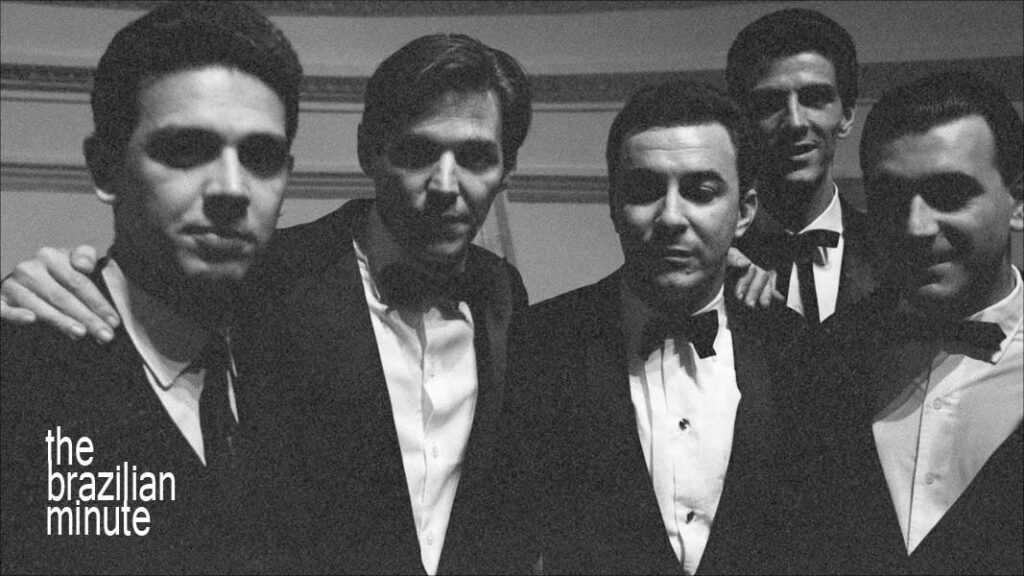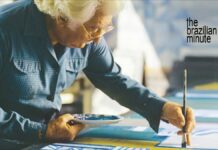
Brazil’s musical gift to the world arrived in 1962.
Explaining Bossa Nova at Carnegie Hall begins with a legendary album, an ambitious American entrepreneur and a perceptive Brazilian diplomat.
This series was presented by the Consulate-General of Brazil in Chicago and the Brazilian Foreign Ministry’s Cultural Department.
In celebration of Brazil’s Bicentennial year, 1822 – 2022
This week’s Brazilian Minute: Explaining Bossa Nova At Carnegie Hall
Catch up with other Brazilian Minute episodes you may have missed!
Script from Original Audio:
2022 marks the 60th anniversary of Bossa Nova at Carnegie Hall. Presented by a music label, a Brazilian airline, and the Consulate-General of Brazil in New York. The date? November 21, 1962.
The concert featured many of Bossa Nova’s young Brazilian stars making their US debuts. Sergio Mendes, Luis Bonfá, Oscar Castro-Neves, João Gilberto, Roberto Menescal, Antonio Carlos Jobim and Carlos Lyra.
Audio problems hampered the concert. But the crowd of three thousand (including VIPs like Tony Bennett and Miles Davis) enjoyed the experience. So did the New York Times.
Months earlier, Stan Getz and Charlie Byrd introduced Bossa Nova to US listeners with their legendary album, Jazz Samba. Yes, it’s true. Bossa Nova, Brazil’s musical gift to the world arrived in 1962.
Read and listen to new weekly episodes of The Brazilian Minute.

Explaining Bossa Nova At Carnegie Hall
Overview
2022 marks the 60th anniversary of the Bossa Nova at Carnegie Hall concert. So, let’s recall Bossa Nova in 1962.
In January, the center of the Brazilian beat was found in a notorious little alley off the backstreets of Copacabana. Tight quarters for several loud after-hours nightclubs.
But not everyone enjoyed the music. Weary, red-eyed apartment dwellers would retaliate by throwing bottles from their balconies. Someone dubbed the alley ‘Beco das Garrafas’ (the alley of bottles), and the nickname stuck.
By year’s end, that noisy rhythm had taken to the stage at New York’s Carnegie Hall.
Opportunity and Diplomacy
For that, we have a Brazilian Ambassador and a New York entrepreneur to thank.
The former was Ambassador Mário Dias Costa. He directed the Cultural Division from the new capital of Brasília. Costa diplomatically organized artist relations for the Carnegie Hall event and traveled with the musicians to assist them.
Then there was Sidney Frey, owner of Audio Fidelity Records, and in some important ways, a self-styled Brazilophile.
He’d been to Brazil as a US sailor in World War II, and he immersed himself in its culture. Especially the music. It is said that Frey’s New York home housed a large collection of Brazilian percussion instruments.
Frey knew the difference between a samba and the Bossa Nova albums he’d heard from New York disc jockey Felix Grant. And because Frey loved jazz, he was intrigued by Jazz Samba, the new album by guitarist Charlie Byrd and saxophonist Stan Getz.
Explaining Bossa Nova At Carnegie Hall: September 1962
Charlie Byrd was an ambassador, too. For Bossa Nova.
The guitarist had just returned from a summer tour of South America organized by the US State Department. And he returned with record albums of Brazil’s new sound. New names, too. Among them? João Gilberto and Antonio Carlos Jobim.
He shared the music with Stan Getz when they met up in early January 1962. Five weeks later, these two found themselves at All Souls Church in Washington, DC to record Jazz Samba.
By September, Jazz Samba and its flagship single ‘Desafinado’ were well on their way to achieving something unimaginable in jazz circles. More than a million copies sold, and #1 on Billboard’s Pop chart.
Sidney Frey’s Audacious Idea
And where was Sidney Frey in September of 1962? He was in the Green Room at the Copacabana Palace in Rio de Janeiro. Ready to hold a well-catered press conference for his plan to bring Bossa Nova to Carnegie Hall.
It was a great idea, one passed along to Frey by the Brazilian vice-consul in New York, Dona Dora Vasconcellos.
The lavish spread and Frey’s audacious idea had their intended effect.
For days, the news swept through Brazilian media like a storm. It caught up with every musician in the city, landing them at the footsteps of the Copacabana Palace, where Frey was taking meetings.
It was stormy inside Rio’s record companies and music publishing houses, too, where the line forming was of a different kind. The bottom line.
Frey returned to New York with a clutch of signed contracts. But back in Rio, uncertainties began to rise with all concerned. Weeks went by. A stalemate occurred and when intercontinental bickering arose, Ambassador Mário Dias Costa arrived to calm the waters.
Who would pay the musicians? Done. Who would pay for airfare and accommodations? Taken care of.
And just like that, the impossible dream was ready for showtime at Carnegie Hall.
Explaining Bossa Nova At Carnegie Hall: November 21, 1962
Tickets for the Bossa Nova concert at Carnegie Hall for ‘front row, center’ would have set you back $4.80 a seat. The balcony was a better deal at just $2.80.
In fact, it was a sound bargain. The Hall’s foyer was filled with the clanking of thousands of coffee cups, saucers, and spoons. They were served up by the IBC (Brazil’s Institute of Coffee) and easily heard on the Main Floor.
This wasn’t the only sound problem of the night. A glance that the stage would capture a “forest of microphones”.
Audio Fidelity was well-positioned to record the entire concert for an upcoming album. There were additional microphones for CBS, Radio Free America, BBC, Free Europe Radio, and Brazil’s Radio Bandeirantes. But the microphones used to fill the hall with Brazil’s ‘new sound’ caused problems throughout the event.
Esteemed jazz journalist Leonard Feather acted as MC to a sold-out audience of about 3,000. Fans even battled inclement weather. Another thousand were turned away. Those in attendance may have spotted luminaries including Tony Bennett, Miles Davis, and Peggy Lee.
But all eyes and ears were on the stage. Sergio Mendes opened the show with his Sextet for ‘One Note Samba’. Then, the audience was treated to many of Bossa Nova’s young rising stars. One of the best highlights was Agostinho das Santos singing ‘Manha De Carnaval’ with guitarist Luís Bonfá.
Jobim’s Moment
Then, and perhaps not fully realizing it, the audience experienced a moment of transformation.
It came shortly after Antonio Carlos Jobim walked onto the stage as the last echoes of applause faded away.
Although this was his first visit to the USA, Jobim was already building a name for himself.
This was largely due to the incredible popularity of his song ‘Desafinado’ and the Jazz Samba album. While nearly a dozen versions had been released in 1962, Jobim was conflicted about this early success.
A day earlier, Jobim was comfortable with the notion of staying home with his wife, Teresa. His reasoning? That he might not live up to expectations.
He arrived in New York just before showtime, and only because his friends insisted that he go. And now, here was Antonio Carlos Jobim taking a New York Second to reflect on a moment he’d dreamed of for years.
The Biggest Step in Jobim’s Life
He strode to his piano, centerstage at the world-famous Carnegie Hall. And he was nervous.
According to Ruy Castro’s book, Bossa Nova, Jobim opened with ‘One Note Samba’ and fumbled with the lyrics. However, he recovered during the first stanza and finished perfectly – even in English – to the sheer delight of the crowd.
He followed with ‘Corcovado’ but started with the wrong key. So, he motioned to guitarist Robert Menescal and drummer Milton Banana to… stop.
Jobim took a breath. Then he started over, delivering a flawless performance in Portuguese and English that brought the house down.
He took a quick bow, ready to leave the stage, but the audience called him back with rapturous applause. And then Jobim said this.
“It’s my first time in New York, and I’m very, very, very glad to be here. I’m loving the people, the town, everything. I’m very happy to be with you.”
As he was speaking, Jobim might have been reflecting on the words of his friend, Fernando Sabino earlier that day. “You’re going to succeed, Tom. Starting tonight, the whole world is going to hear you.”
It was Sabino who took Jobim to the airport and waited there until Jobim boarded the plane.
João Gilberto’s Pants
João Gilberto closed the show, and a mishap leading up to his performance is a story in itself.
During his flight to New York, a crease on João Gilberto’s dress pants decided to take a different route, which was completely unacceptable. So, Gilberto quickly summoned Mário Dias Costa.
“Look, Mário. It’s not straight. I can’t go on like this.” As the story goes, Gilberto had a right to be concerned. After all, pianists and drummers could hide their legs easily, but for a guitarist?
But it was vice-consul Dona Dora Vasconcellos who quickly resolved the show-stopping dilemma. She rushed to the Carnegie’s seamstress and together, they forced open the door to the ironing room. Jeito realized. Perfect crease. Problem solved.
Minutes later, a calm and confident João Gilberto was welcomed to the stage with Leonard Feather’s introduction. Photographers rushed to the front. This was who they came to see.
Gilberto waited for complete silence.
Then he began to sing. First, it was ‘Samba da Minha Terra’ and ‘Outra Vez’ with drummer Milton Banana’s soft playing. Then, Antonio Carlos Jobim joined them for ‘Corcovado’ and ‘Desafinado’.
Gilberto’s tone and performance were immaculate, and he received a thunderous ovation.
Planning For An Extended Stay
With the exception of Luís Bonfá, none of these performers (see our list below) had traveled before to the USA. They knew that Carnegie Hall represented a career-building opportunity.
So did the after-party thrown by Sidney Frey, where contracts were offered to several of the musicians to continue their stay in the USA.
New York’s famed Blue Angel nightclub offered a three-week run to João Gilberto, and Verve Records sweetened the idea with an album contract.
Jobim signed on with Leeds as an arranger, while Oscar Castro-Neves landed at the Empire Room at the Waldorf Astoria. Sergio Mendes proved that he had what it took to become a star.
A White House Visit
For most, it was time to head back to Brazil. For those who stayed, another concert was just a few weeks in the future. It was held in Washington DC, at the George Washington Auditorium with Jobim, Gilberto, Mendes, Menescal, and Carlos Lyra.
Afterward, the musicians were invited to the White House by the First Lady, Jackie Kennedy.
In a single year, the gang who invented the Bossa sound in back-alley clubs that were routinely pelted with empty beer bottles from high-rise apartments found themselves in the White House.
Sipping champagne.
Bossa Nova at Carnegie Hall
Musicians
- João Gilberto
- Antonio Carlos Jobim
- Sergio Mendes
- Oscar Castro-Neves
- Roberto Menescal
- Milton Banana
- Ana Luca
- Agostinho dos Santos
- Luís Bonfá
- Sergio Ricardo
- Normando Santos
- Chico Feitosa
- Carlos Lyra
- Caetano Zama
- Bola Sete
- Carmen Costa
- Jose Paulo
- Charlie Byrd
- Stan Getz
- Gerry Mulligan
- Gary Burton
- Gary McFarland
- Lalo Schifrin
Explaining Bossa Nova At Carnegie Hall
Did you enjoy ’Explaining Bossa Nova At Carnegie Hall’? If you did, why not join us at Connect Brazil?
Sign Up for our e-letter. Listen to Brazil Back2Back on demand and our live streaming station. Explore our top stories and streaming channels, always free. Like our Facebook page, and follow us on X (Twitter) and Instagram.










